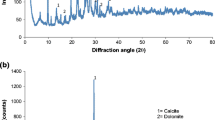Abstract
The paper presents the results of antimony removal from the Dúbrava water resource using a pilot plant system capable of taking samples from different heights of adsorption materials. The adsorbents GEH, CFH12, CFH18, and Bayoxide E33 and two experimental stainless columns with bleeder valves located at heights of 20, 45, and 70 cm of the adsorption media and 91 cm (GEH), 94 cm (CFH18), 87 cm (CFH12), and 87 cm (Bayoxide E33) filter media high were used. The results of the experiments show that the most suitable material for removing antimony from water is GEH. For an antimony concentration of 78.4–108.0 μg/L in raw water and a filtration rate of 5.6–5.9 m/h, the limit concentration of 5 μg/L at the outlet of the 70-cm high adsorption media was reached at the bed volume 1788. In a case when the media height was 91 cm, the antimony concentration in the treated water would reach the limit value of 5 μg/L after a 672-h operation of the stainless column at the bed volume 4256. Under these conditions, the adsorption capacity was calculated at 184 μg/g. The adsorption capacities and bed volumes of the other adsorbents were lower in comparison to GEH.





Similar content being viewed by others
References
AWWA (1990). Water quality and treatment. A handbook of community water suppliers.
Backman, B., Kettunen, V., Ruskeeniemi, T., Luoma, S., & Karttunen, V. (2007). Arsenic removal from groundwater and surface water—field tests in the Pirkanmaa Region Finland (pp. 1–40). Espoo: Geological Survey of Finland.
Bailey, S. E., Olin, T. J., Bricka, R. M., & Adrian, D. D. (1999). A review of potentially low—cost sorbents for heavy metals. Water Research, 33(11), 2469–2479.
Bissen, M., & Frimmel, F. H. (2003). Arsenic—a review; part II: oxidation of arsenic and its removal in water treatment. Acta Hydrochimica et Hydrobiologica, 31(2), 97–107.
Council Directive 98/83/EC (1998). Quality of water intended for human consumption.
Cumming, L. J., Wang, L., & Chen, A. S. C. (2009). Arsenic and antimony removal from drinking water by adsorptive media, U.S. EPA Demonstration Project at South Truckee Meadows General Improvement District (STMGID), NV Final Performance Evaluation Report, (EPA/600/R-09/016).
Driehaus, W., Jekel, M., & Hildebrandt, U. (1998). Granular ferric hydroxide—a new adsorbent for the removal of arsenic from natural water. Journal of Water Supply Research and Technology-Aqua, 47(1), 30–35.
Gannon, K., & Wilson, D. J. (1986). Removal of antimony from aqueous system. Separation Science and Technology, 21(5), 475–493.
GEH-Wasserchemie (2014). http://www.geh-wasserchemie.de/files/datenblatt_geh101_en_web.pdf.
Ilavský, J., & Barloková, D. (2012). The use of granular iron-based sorption materials for nickel removal from water. Polish Journal of Environmental Studies, 21(5), 1229–1236.
Jekel, M., & Seith, R. (2000). Comparison of conventional and new techniques for the removal of arsenic in a full scale water treatment plant. Water Supply, 18(1), 628–631.
Jiang, W., Pelaez, M., Dionysiou, D. D., Entezari, M. H., Tsoutsou, D., & O’Shea, K. (2013). Chromium(VI) removal by maghemite nanoparticles. Chemical Engineering Journal, 222(15), 527–533.
Kemwater ProChemie (2014). http://www.prochemie.cz/chem/tech-list-hydroxid-zelezity-kemira-cfh.pdf.
MacPhee, M. J., Charles, G. E., & Cornwell, D. A. (2001). Treatment of arsenic residual from drinking water removal prosesses. (EPA/600/R-11/090).
Mohan, D., & Pittman, C. U., Jr. (2007). Arsenic removal from water/wastewater using adsorbents—a critical review. Journal of Hazardous Materials, 142(1–2), 1–53.
Munka, K., Olejko, Š., Varga, S., & Zaťko Š. (1999). Návrh technológie odstraňovania antimónu z vodných zdrojov SKV Dúbrava a Partizánska Ľupča. Záverečná správa, VÚVH Bratislava, 1999. Design of technology for removal of antimony from water resources Dúbrava and Partizánska Ľupča. Final report, Water Research Institut Bratislava. (in Slovak).
Naeem, A., Westerhoff, P., & Mustafa, S. (2007). Vanadium removal by metal (hydr)oxide adsorbents. Water Research, 41(7), 1596–1602.
Nguyen, V. L., Chen, W. H., Young, T., & Darby, J. (2011). Effect of interferences on the breakthrough of arsenic: rapid small scale column tests. Water Research, 45(14), 4069–4080.
Pitter, P. (2009). Hydrochemie (4th ed.). Praha: Institute of Chemical Technology Press (in Czech).
Rubel, F., Jr. (2003). Design manual: Removal of arsenic from drinking water by adsorptive media (EPA/600/R-03/019).
Severn Trent Services (2014). http://www.severntrentservices.com/en_us/LiteratureDownloads/Documents/565_0200.pdf.
Sperlich, A., Werner, A., Genz, A., Amy, G., Worch, E., & Jekel, M. (2005). Breakthrough behavior of granular ferric hydroxide (GFH) fixed-bed adsorption filters: modeling and experimental approaches. Water Research, 39(6), 1190–1198.
Thirunavukkarasu, O. S., Viraraghavan, T., & Subramanian, V. (2003). Arsenic removal from drinking water using granular ferric hydroxide. Water SA, 29(2), 161–170.
US EPA (2003). Arsenic treatment technology evaluation handbook for small systems, Office of water (4606M), EPA 816-R-03-014.
US EPA. (1984). Antimony: an environmental and health effects assessment. Washington, DC: US Environmental Protection Agency, Office of Drinking Water.
Westerhoff, P., Highfield, D., Badruzzaman, M., & Yoon, Y. (2005). Rapid small scale column tests for arsenate removal in iron oxide packed bed columns. Journal of Environmental Engineering, 131(2), 262–271.
WHO. (2003). Antimony in drinking-water. Background document for preparation of WHO Guidelines for drinking-water quality. Geneva: WHO.
WHO. (2011). Guidelines for drinking-water quality (4th ed.). Geneva: WHO.
Zeng, H., Arashiro, M., & Giammar, D. (2008). Effect of water chemistry and flow rate on arsenate removal by adsorption to an iron-based sorbent. Water Research, 42(18), 4629–4636.
Acknowledgments
The experimental measurements were carried out with the financial support of the APVV-0379-07 project from the Slovak Research and Development Agency and VEGA 1/1243/12 research project from the Scientific Grant Agency of the Slovak Ministry of Education.
Author information
Authors and Affiliations
Corresponding author
Rights and permissions
About this article
Cite this article
Ilavský, J., Barloková, D. & Munka, K. Antimony Removal from Water by Adsorption to Iron-Based Sorption Materials. Water Air Soil Pollut 226, 2238 (2015). https://doi.org/10.1007/s11270-014-2238-9
Received:
Accepted:
Published:
DOI: https://doi.org/10.1007/s11270-014-2238-9



